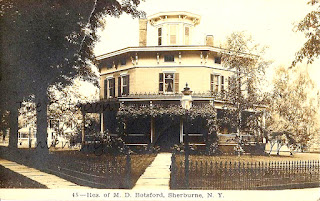 |
| Fowler's book that started the Octagon House craze. |
In 1848, Orson S. Fowler, a Yankee individualist and progressive social thinker, published a book entitled The Octagon House: A Home For All.
In it, he argued the advantages of an eight-sided house over the standard four-sided variety. Windows on all sides offer more light and better air circulation which, in turn, lowers heating and cooling expenses. An octagon also cost less to construct, requiring shorter spans of lumber than conventional buildings.
Fowler's architectural ideas were popular in the East, where most octagonal structures and homes were built. However, the popularity of this architectural style almost completely died out by the time of the Civil War. During their popularity, a few thousand octagon homes and structures were built in the United States, but they never lined neighborhoods like more traditional styles. Today, most of the several hundred surviving examples can be found in the Midwest, New York and Massachusetts. They range from humble, unadorned country dwellings to elaborate mansions.
Unfortunately, Fowler's own 60-room estate, "Fowler's Folly" near Fishkill, N.Y., is no longer standing.
Inventory of Older Octagon, Hexagon, and Round Houses is the most comprehensive source on octagon houses compiled. According to their records the number of standing old houses in the inventory in year 2010 stands at 404 and the number of structures in the inventory in year 2010 stands at 998.
Features to look for:
- Eight-sided shape of exterior walls. (A few are six-, ten-, twelve-, sixteen-sided or round.)
- Two stories (Some have raised basements and a few have up to four stories.)
- Low-pitched, hipped roofs with wide overhanging eaves.
- Eave brackets, when Italianate.
- Eight-sided belvederes (cupolas), often placed above a central stairway and covered with glass or shutters.
- Encircling veranda or porch, sometimes balconies on the second floor.
- Many show Greek Revival, Gothic Revival, or Italianate decorative details; others lack detailing
- Minimal ornamental detailing
 |
| The Hill-Jones Octagon House Cedar Point, NC |
Pictured above is the Hill-Jones Octagon House as it stands today in Cedar Point, NC. Below are images of several other examples of Octagon Houses to compare their likenesses and subtle differences... note the common features listed above.
 |
| The Hill-Jones Octagon House Cedar Point, NC |











